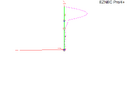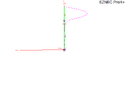I took down the Skipshooter, and put up a Semi-duster. That's a Starduster that I drilled and tapped out the radial holes to 3/8-24, so I can use about any whip in America.
You are using an out of date browser. It may not display this or other websites correctly.
You should upgrade or use an alternative browser.
You should upgrade or use an alternative browser.
-
You can now help support WorldwideDX when you shop on Amazon at no additional cost to you! Simply follow this Shop on Amazon link first and a portion of any purchase is sent to WorldwideDX to help with site costs.
-
A Winner has been selected for the 2025 Radioddity Cyber Monday giveaway! Click Here to see who won!
Dumb ???? #3 (about radial length)
- Thread starter wyojeepeer
- Start date
I was looking that up because if I put a RF choke on my antenna, it was recommended to put it 1 to 2 meters below the feed point. My thought was having it at a percentage of a wave length would be best. EG :1/8 wave. Have fun trying to figure that out when the VF is all over the place.
Im afraid that has litlle use, but it is a good way to start a myth...
First thing would be the velocity factor:
- The common mode currents run on the outside of the coax.
THERE IS (besides some material loss) NO VELOCITY factor.
Secondly, the ideal distance of the Choke depends...on the number of radials the thickness and length of them etc.
Best option would be to attach one or more radials on your half wave end-fed
And place the Choke at a distance of 0.1 ..0.15 lambda from the feedpoint.
The ideal length varies a bit but longer then 0.15 is never a good option.
More importantly would be to make sure the choke impedance is high enough ( you could measure this with a nano-vna or similair).
If you dont have one...4 turns 10cm diameter and leave the choke hanging ...dont attach it to metal.
Kind regards, Henry
OK, got everything but that...... What the heck is a Lambda????of 0.1 ..0.15 lambda
I made an assumption that the VF would have an effect on the coax. I don't see that it doesn't. Are you saying that coax shield has no VF? How can that be? And if it does, then wouldn't having a fraction of a wave length make sense?
As you have an RF wave going through the antenna, is that not effected by the material of the antenna. Steel, copper, and aluminum all resonate at a different frequency, (please read that as VF) why would the coax braid be different? after all, isn't it a part of the "counterpoise".....
Still confused....
John.
Keep asking with whatever is confusing you.OK, got everything but that...... What the heck is a Lambda????
I made an assumption that the VF would have an effect on the coax. I don't see that it doesn't. Are you saying that coax shield has no VF? How can that be? And if it does, then wouldn't having a fraction of a wave length make sense?
As you have an RF wave going through the antenna, is that not effected by the material of the antenna. Steel, copper, and aluminum all resonate at a different frequency, (please read that as VF) why would the coax braid be different? after all, isn't it a part of the "counterpoise".....
Still confused....
John.
It most likely is my bad explination, Im trying to learn about antennas everyday...so I take some things for granted....which obviously they are not always good to get things right !
Lambda is the same as wavelength.
(Or I believe it is the word for the greek capital letter λ which is the symbol for wavelength.)
Yes, a coax cable has a VF...you mentioned that 0.75..0.8 previously.
That VF is for the signal travelling inside the coax.
One of the reasons it has a velocity factor is because the inside of the coax isnt `air` but the space between the inner conductor and outer conductor made from non guiding material ....its an isolator...to seperate those two. (you dont want a short circuit). The signal has different speeds for various materials.
One of the reasons the VF can be different.
But you are trying to block a signal on the outside of the coax cable.....not the inside... on the outside of the coax there is a litlle bit of plastic and air...
So the velocity factor isnt what you were trying to find out (that .75 ) but it would be more in the order of .98
The outside of the coax doesnt have a velocity factor (besides the material loss ....(velocity factor) as previously mentioned)
Yes ....materials can have effect...
But that is minimal....you wont notice the dfference between aluminium and copper.
When both have the same diameter the resonant frequency will be the same.
Diameter in general has far more influence on length.
For example:
A resonant halve wave antenna with a 2mm diameter wire has a different length then a 20mm diameter resonant halve wave (for the same frequency).
It is very easy to reach more then 1MHz difference with different diameters on 27Mhz. That also means the length of that resonant antenna will change significant....difference in the order of 4..5 inches are not uncommon
(again for the same antenna ..same resonant frequency...just different diameter).
Hope this helps to get a better idea?
Last edited:
So....So the velocity factor isnt what you were trying to find out (that .75 ) but it would be more in the order of .98
I've been thinking about this for a week, and wandering thru a lot of websites.
I found that "the DB" (on another site) agrees with you at .99.
Using .1 wave, I got 36" (1/10 wave), for the placement of the RF choke.
Using .15 wave, the answer was 54" (1/8 wave).
I think that the next place it would work is at 9'.
Mounting the choke at any distance from the feed point, it only makes sense, to me, that it "should" work better at a fraction of the wave length.
I'm guessing the way I'm thinking isn't completely out to lunch.
Thanks for your help.
John
Last edited:
That would have been me, I don't think anyone else used that name anywhere, at least radio related.
It would have been years ago. All of the other forums I did anything I left for mostly lack of use.
I have said many times that the optimal place for a choke on a 1/2 wavelength antenna is 1/4 wavelength down from the feed point. Putting such a choke at the feed point on such antenna can be an effort in futility... I may have said other things in years past because as I learn more my stance on, or even how I explain things, evolves.
I had models showing the effects of choke placement, but I guess they were to old to make it into the photo gallery on this site, so I don't have them to drop in. When I get a chance I'll see about making models to show why I say that visually.
I haven't really posted in this thread because Henry is a knowledgeable guy and seemed to be handling it well, but I'm happy to put in my 2 cents if it helps.
Gimme a bit, I have an errand I have to do, then I will whip up said models for you.
The DB
It would have been years ago. All of the other forums I did anything I left for mostly lack of use.
I have said many times that the optimal place for a choke on a 1/2 wavelength antenna is 1/4 wavelength down from the feed point. Putting such a choke at the feed point on such antenna can be an effort in futility... I may have said other things in years past because as I learn more my stance on, or even how I explain things, evolves.
I had models showing the effects of choke placement, but I guess they were to old to make it into the photo gallery on this site, so I don't have them to drop in. When I get a chance I'll see about making models to show why I say that visually.
I haven't really posted in this thread because Henry is a knowledgeable guy and seemed to be handling it well, but I'm happy to put in my 2 cents if it helps.
Gimme a bit, I have an errand I have to do, then I will whip up said models for you.
The DB
So here I will start with a base model that shows a half wavelength antenna in a worst case scenario.
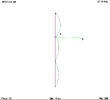
In this case, the circle is the feed point. Everything above it represents the antenna, and everything below it represents the feed line.
The green curved line is the current distribution on the model, the further away from the antenna the stronger the current is on that part of the antenna. Essentially, for this antenna, you want to get all of it, or at least as much as possible, above the feed point. Anything below that point almost always (except a few rare instances) works against you, and your efforts to make contacts.
Next is a model of the same antenna with the choke right below the feed point.
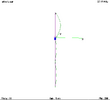
The blue box is the choke, and in the models shown here it is 9000 ohms, simulating an air choke.
In this case it has some effect, but could be better. I've made models in the past where putting a choke in this spot did almost nothing. This difference is either related to the new (to me) nec 5 engine calculating currents differently, or me not finding the exact right lengths for this antenna model in the short time I'm putting these together.
We definitely still have common mode currents, although definitely less of them.
And finally, 1/4 wavelength down from the feed point.
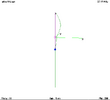
Here we see a few common mode currents above the choke, but essentially none below the choke. This is, to me, a more desirable current distribution. Using past models, I can actually use far less than 9000 ohms and get the same result as this. The reason for this is chokes are a current devices, essentially they resist the flow of current. Because of this, they tend to be more effective where the current is at its maximum on the antenna.
I hope this helps explain why I say to choke the a99 1/4 wavelength down from the feed point.
The DB

In this case, the circle is the feed point. Everything above it represents the antenna, and everything below it represents the feed line.
The green curved line is the current distribution on the model, the further away from the antenna the stronger the current is on that part of the antenna. Essentially, for this antenna, you want to get all of it, or at least as much as possible, above the feed point. Anything below that point almost always (except a few rare instances) works against you, and your efforts to make contacts.
Next is a model of the same antenna with the choke right below the feed point.

The blue box is the choke, and in the models shown here it is 9000 ohms, simulating an air choke.
In this case it has some effect, but could be better. I've made models in the past where putting a choke in this spot did almost nothing. This difference is either related to the new (to me) nec 5 engine calculating currents differently, or me not finding the exact right lengths for this antenna model in the short time I'm putting these together.
We definitely still have common mode currents, although definitely less of them.
And finally, 1/4 wavelength down from the feed point.

Here we see a few common mode currents above the choke, but essentially none below the choke. This is, to me, a more desirable current distribution. Using past models, I can actually use far less than 9000 ohms and get the same result as this. The reason for this is chokes are a current devices, essentially they resist the flow of current. Because of this, they tend to be more effective where the current is at its maximum on the antenna.
I hope this helps explain why I say to choke the a99 1/4 wavelength down from the feed point.
The DB
Excellent PostSo here I will start with a base model that shows a half wavelength antenna in a worst case scenario.
View attachment 72895
In this case, the circle is the feed point. Everything above it represents the antenna, and everything below it represents the feed line.
The green curved line is the current distribution on the model, the further away from the antenna the stronger the current is on that part of the antenna. Essentially, for this antenna, you want to get all of it, or at least as much as possible, above the feed point. Anything below that point almost always (except a few rare instances) works against you, and your efforts to make contacts.
Next is a model of the same antenna with the choke right below the feed point.
View attachment 72896
The blue box is the choke, and in the models shown here it is 9000 ohms, simulating an air choke.
In this case it has some effect, but could be better. I've made models in the past where putting a choke in this spot did almost nothing. This difference is either related to the new (to me) nec 5 engine calculating currents differently, or me not finding the exact right lengths for this antenna model in the short time I'm putting these together.
We definitely still have common mode currents, although definitely less of them.
And finally, 1/4 wavelength down from the feed point.
View attachment 72897
Here we see a few common mode currents above the choke, but essentially none below the choke. This is, to me, a more desirable current distribution. Using past models, I can actually use far less than 9000 ohms and get the same result as this. The reason for this is chokes are a current devices, essentially they resist the flow of current. Because of this, they tend to be more effective where the current is at its maximum on the antenna.
I hope this helps explain why I say to choke the a99 1/4 wavelength down from the feed point.
The DB
73
Jeff
Removed in order to make things less complicated.
Attachments
Last edited:
I would like to add:
The above is true if the antenna/coax/radio has NO connection to earth.
But often there is such a path...
Its actually not the connection to the earth itself that is causing that, its just that the connection to the earth changes things in such a way that that happens to have that effect. The same thing can be done without any earth present. Here is a hint that you likely don't need, what change in the current distribution results from connecting an open circuit to an earth? Anyway...
Henry, look. We are both trying to help others, and you have earned my (and many others) respect. I am also aware that you have a higher level of knowledge about most antenna topics than I do. However, pointing out more advanced details when I am trying to talk to someone at their own level and guide them in a direction that is beneficial to them only adds confusion for the person being helped.
This isn't the first time you mentioned something that I was already aware of when trying to help others, and it is frustrating. I am well aware that as you change the length of the feed line on this antenna, and what is attached at the other end of said feed line, the optimal position for the choke can vary to some degree. So I ask you this, how does that knowledge help the person I was trying to help? Seriously, right now there are maybe 10 active users on this forum that have the ability and tools to find such a location on the coax to put a choke at said optimal place on a real world antenna setup right now. Because of this, I did a lot of modeling to find the spot that gives the most benefits over a wide range of feed line lengths as possible, and guess where I was trying to direct the op with an explanation that he can understand?
If you want to get into more advanced discussions about this or any other topics, I'm happy to give my thoughts and experiment and see what I can find out (assuming I am not stuck at work 60+ hours a week like sometimes happens). But lets keep it away from a thread that we are actively helping people out. Its not helpful to them and often is jsut confusing.
The DB
Edit:
After consideration..
Certainly wasnt intended to irriate you or make things more complicated.
Therefor ill remove the post as that will make things less complicated.
Ill try to keep it into future consideration, though i do get carried away into detail every now and then, hope u can forgive me hihi.
Keep up the good work !
After consideration..
Certainly wasnt intended to irriate you or make things more complicated.
Therefor ill remove the post as that will make things less complicated.
Ill try to keep it into future consideration, though i do get carried away into detail every now and then, hope u can forgive me hihi.
Keep up the good work !
Last edited:

